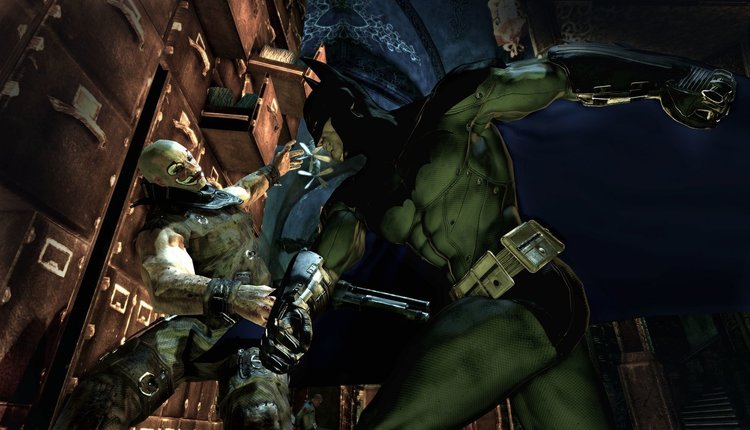The Definitive Superhero Game | Batman: Arkham Asylum at 10
When the first promotional images for Batman: Arkham Asylum arrived in Summer 2008, it felt very much like business as usual. Throughout the 00s, licensed superhero games were common enough, many of them looked like they’d be winners early on, only to disappoint upon release. So, when we heard of a game that allowed you to ‘become’ Batman, that it would celebrate his enormous cast of characters and (at that point) 70 years of comics history, it all felt as familiar and unremarkable as Adam West’s Bat-physique.
Still smarting from the devastating disappointment of the Superman Returns game (the entire reason I bought an Xbox 360), I remember hoping against hope that it would at least be as good as some of the recent Spider-Man games. As release drew closer, more and more promotional material was released and it became clear that publisher Eidos Interactive really believed in the game. Maybe it was time to start getting excited?
I’ll never forget the day the reviews came out. The game wasn’t just being praised, it was like a gushing fountain of celebration. I remember showing the Games Master magazine (RIP) review to my friends (who understandably turned their noses up at licensed games) and basking in their shocked reactions. It had taken incarceration to truly free Batman.
A decade on, it’s still a great game. Eschewing the always unwelcome practice of boring you with the details, Batman: Arkham Asylum thrusts you immediately into the plot, as Batman is delivering the Joker back to the Asylum yet again (they need better locks). Of course something goes wrong, the madman runs free and before long, he’s running the madhouse.
The rest of the plot is nothing special – a hodge podge of convenient reasons lead to Batman bumping into a half dozen or so of his Greatest Enemies(™). This leads to some really memorable sequences – the iconic Scarecrow fear sequences – and some dodgy boss fights – the Poison Ivy fight is fun but it has more than a sniff of something from an old Crash Bandicoot sequel.
Kevin Conroy and Mark Hamill firmly cemented themselves as the definitive voices of Batman and the Joker. While the former is not given much to work with – “You’re finished, Joker!” – the latter greatly benefits from a more adult-oriented script and aesthetic, especially compared to the famously restrained animated series where the Joker was never actually allowed to kill anyone.
https://www.youtube.com/watch?v=lFQd-_9LixY
The stealth mechanics are spot-on, it’s always gas how conveniently placed the indoor gargoyles are, allowing Batman the ability to gain the high ground and contemplate his next move. Gliding is fun, but if you’ve played the sequels, this is a much more embryonic version of what the gliding mechanic eventually became.
The secret weapon of Batman: Arkham Asylum is the masterful combat – the genius of which is how easy and intuitive it is to pick up but how excruciatingly difficult it is to master. I’ve still never broken a million in the infinite wave ‘Totally Insane’ challenge map, not for lack of hours and hours trying. Those fucking lunatics that jump on top of you, man.
[perfectpullquote align=”full” bordertop=”false” cite=”” link=”” color=”#70006C” class=”” size=”19"]”You realise an hour or so in that you’re not playing another Batman game, you’re playing the Batman game”.[/[/perfectpullquote]p>
What sets Batman: Arkham Asylum apart from its successors is its claustrophobic setting. Elsewhere in the Batman mythos, Arkham is either portrayed as a decaying mansion from another time or a high-tech Fort Knox-like leviathan of high-tech security with elaborate, bespoke cells designed for containment rather than any hope of rehabilitation – if they sound like two very different things, it’s because they are – and the game embraces them. The older mansion is beautifully decrepit, but off to the side is the labyrinthine ‘Intensive Treatment’, where elaborately mechanical automatic doors hide the mysteries of the asylum almost as well as they hide load times.
Unlike the steampunk vibe of Arkham City or the sleek, 1960s retro-futurism of Arkham Knight, everything in the Asylum and Intensive Treatment is beaten down and broken and downright crappy-looking in the best way possible. Flickering CRT monitors that were probably second rate in the 1980s, dusty old yellow file pages strewn on the cracked tiles of the library, a tinny little fan spinning awkwardly above… perfect.

After the game’s enormous success, the obvious next step was to expand the map to a more traditional, urban setting. Arkham City did this perfectly, but the argument can certainly be made that the theme park-esque rooftops of old Gotham could never feel as tightly designed as the brooding hallways, nor could they match the Metroid-esque feeling of slow, methodical advancement through an environment. This is even more true of Arkham Knight (paradoxically my personal favourite entry in the three-game series, even if it’s unmistakably the most flawed) where the introduction of a galmorphinizing Batmobile flew the series far too close to the sun.
Wherever the series ends up, there’s no doubting its enormous impact not only on other superhero games such as Marvel’s Spider-Man but on dozens of other action/stealth games like Shadow of Mordor, Sleeping Dogs, and even some of the newer Assassin’s Creeds. Batman: Arkham Asylum draws you into its world so beautifully, quickly establishing itself as above and beyond anything that came before. You realise an hour or so in that you’re not playing another Batman game, you’re playing the Batman game.

